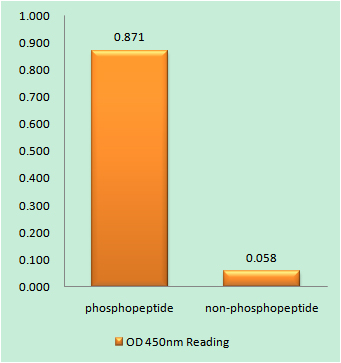Tuberin (phospho Thr1462) Polyclonal Antibody
- Catalog No.:YP0968
- Applications:WB;IHC;IF;ELISA
- Reactivity:Human;Mouse;Rat
- Target:
- Tuberin
- Fields:
- >>Phospholipase D signaling pathway;>>p53 signaling pathway;>>Autophagy - animal;>>mTOR signaling pathway;>>PI3K-Akt signaling pathway;>>AMPK signaling pathway;>>Longevity regulating pathway;>>Cellular senescence;>>Thermogenesis;>>Insulin signaling pathway;>>Thyroid hormone signaling pathway;>>Human cytomegalovirus infection;>>Human papillomavirus infection;>>Herpes simplex virus 1 infection;>>Choline metabolism in cancer
- Gene Name:
- TSC2
- Protein Name:
- Tuberin
- Human Gene Id:
- 7249
- Human Swiss Prot No:
- P49815
- Mouse Swiss Prot No:
- Q61037
- Rat Gene Id:
- 24855
- Rat Swiss Prot No:
- P49816
- Immunogen:
- The antiserum was produced against synthesized peptide derived from human Tuberin/TSC2 around the phosphorylation site of Thr1462. AA range:1428-1477
- Specificity:
- Phospho-Tuberin (T1462) Polyclonal Antibody detects endogenous levels of Tuberin protein only when phosphorylated at T1462.
- Formulation:
- Liquid in PBS containing 50% glycerol, 0.5% BSA and 0.02% sodium azide.
- Source:
- Polyclonal, Rabbit,IgG
- Dilution:
- WB 1:500-2000 IHC 1:100 - 1:300. IF 1:200 - 1:1000. ELISA: 1:5000. Not yet tested in other applications.
- Purification:
- The antibody was affinity-purified from rabbit antiserum by affinity-chromatography using epitope-specific immunogen.
- Concentration:
- 1 mg/ml
- Storage Stability:
- -15°C to -25°C/1 year(Do not lower than -25°C)
- Other Name:
- TSC2;TSC4;Tuberin;Tuberous sclerosis 2 protein
- Observed Band(KD):
- 200kD
- Background:
- Mutations in this gene lead to tuberous sclerosis complex. Its gene product is believed to be a tumor suppressor and is able to stimulate specific GTPases. The protein associates with hamartin in a cytosolic complex, possibly acting as a chaperone for hamartin. Alternative splicing results in multiple transcript variants encoding different isoforms. [provided by RefSeq, Jul 2008],
- Function:
- alternative products:Additional isoforms seem to exist. Experimental confirmation may be lacking for some isoforms,disease:Defects in TSC2 are a cause of lymphangioleiomyomatosis (LAM) [MIM:606690]. LAM is a progressive and often fatal lung disease characterized by a diffuse proliferation of abnormal smooth muscle cells in the lungs. It affects almost exclusively young women and can occur as an isolated disorder or in association with tuberous sclerosis complex.,disease:Defects in TSC2 are the cause of tuberous sclerosis complex (TSC) [MIM:191100]. The molecular basis of TSC is a functional impairment of the tuberin-hamartin complex. TSC is an autosomal dominant multi-system disorder that affects especially the brain, kidneys, heart, and skin. TSC is characterized by hamartomas (benign overgrowths predominantly of a cell or tissue type that occurs normally in the organ) and hamartias (de
- Subcellular Location:
- Cytoplasm. Membrane; Peripheral membrane protein. At steady state found in association with membranes.
- Expression:
- Liver, brain, heart, lymphocytes, fibroblasts, biliary epithelium, pancreas, skeletal muscle, kidney, lung and placenta.
- June 19-2018
- WESTERN IMMUNOBLOTTING PROTOCOL
- June 19-2018
- IMMUNOHISTOCHEMISTRY-PARAFFIN PROTOCOL
- June 19-2018
- IMMUNOFLUORESCENCE PROTOCOL
- September 08-2020
- FLOW-CYTOMEYRT-PROTOCOL
- May 20-2022
- Cell-Based ELISA│解您多样本WB检测之困扰
- July 13-2018
- CELL-BASED-ELISA-PROTOCOL-FOR-ACETYL-PROTEIN
- July 13-2018
- CELL-BASED-ELISA-PROTOCOL-FOR-PHOSPHO-PROTEIN
- July 13-2018
- Antibody-FAQs
- Products Images

- Western blot analysis of 293 using p-Tuberin (T1462) antibody.

- Enzyme-Linked Immunosorbent Assay (Phospho-ELISA) for Immunogen Phosphopeptide (Phospho-left) and Non-Phosphopeptide (Phospho-right), using Tuberin/TSC2 (Phospho-Thr1462) Antibody

- Immunohistochemistry analysis of paraffin-embedded human breast carcinoma, using Tuberin/TSC2 (Phospho-Thr1462) Antibody. The picture on the right is blocked with the phospho peptide.


